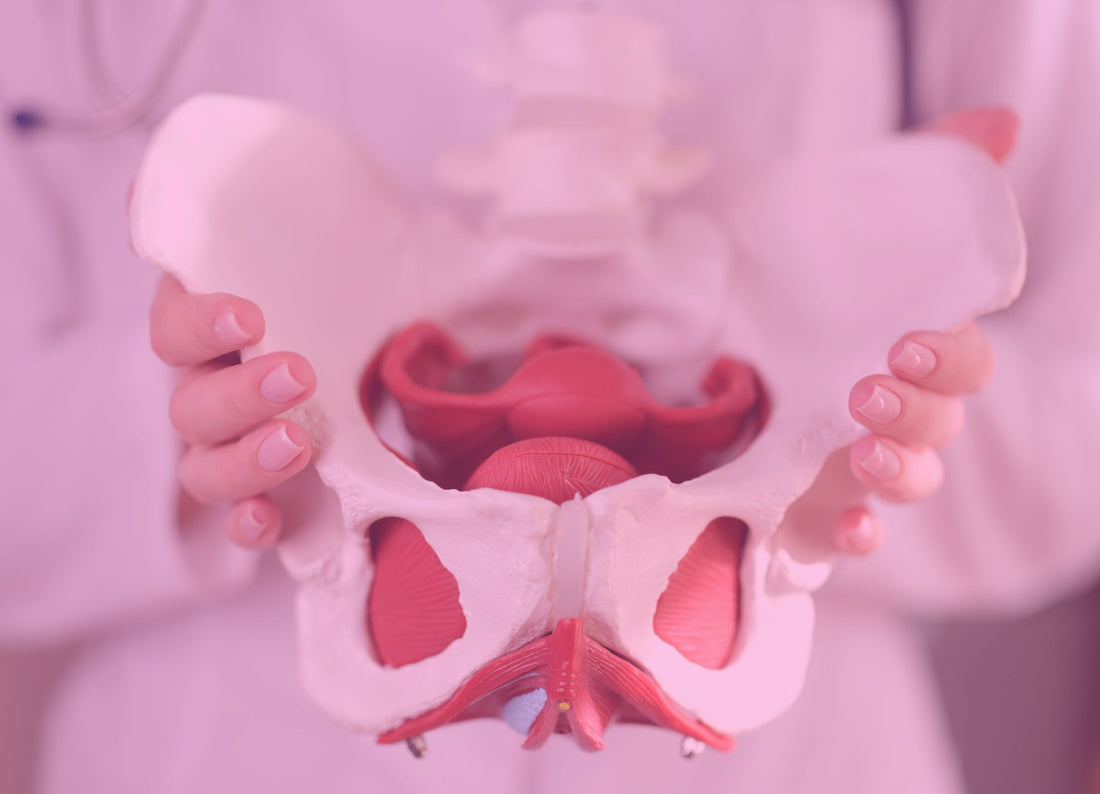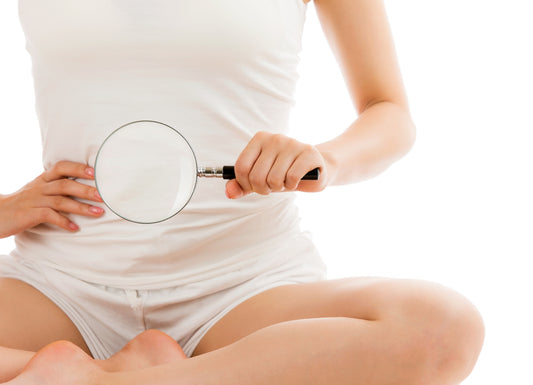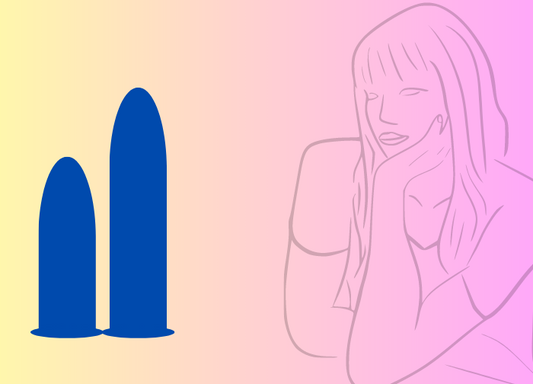Pelvic pain is defined as pain in the lower trunk area between the navel and the thighs. When women experience sharp pain in the pelvic area, it can indicate PMS, menstruation, or ovulation, as well as digestive issues, or something more serious that could require immediate medical treatment.
Below, we’ll discuss in greater detail what sharp pain in women’s pelvic area means, the potential causes, and available treatments.
Causes of Stabbing Pain in Women's Pelvic Area
1. Menstrual Cramping
Menstrual cramping is one of the most common symptoms of PMS and one of the most frequent causes of pelvic pain. In fact, over 50% of menstruating women experience pelvic pain from menstrual cramping for 1-2 days before their period occurs.
Applying heat in the form of a heat-pad or hot water bottle to the lower back and lower belly helps to relieve this type of pelvic pain as well as over-the-counter pain medication like Advil, Aleve, or ibuprofen.
2. Ovulation
When women feel a sharp pain in the middle of the menstrual cycle that is located on either the left or right side of the pelvis, it is more than likely a symptom of the body going through ovulation.
During ovulation, the ovaries (on either the left or right side - it usually alternates from month to month) release an egg along with some fluid, which then moves down through the fallopian tube and into the uterus. It doesn’t always occur, but when some of the released fluid from the ovary seeps into the belly or abdominal cavity, it can cause a little irritation and result in pelvic pain on one side.
Pelvic pain caused by ovulation does not normally last very long, a few minutes for some, a few hours for others. So pain medication is not usually necessary, but to feel relief, over-the-counter pain medications like Advil, Aleve, or ibuprofen are recommended.
3. Urinary Tract Infection or Cystitis
A urinary tract infection (UTI) is considered one of the most common infections in the human body. Although typically caused by bacteria entering the urinary tract, UTIs can infect any part of the urinary system including the urethra, bladder, ureters, and kidneys. That said, the majority of women experience an infection of the bladder, which is referred to as Cystitis.
Most UTIs and cases of cystitis will rectify themselves as long as you drink lots of water to help flush the bacteria out, but some cases require antibiotics. However, if you suffer from recurring UTIs, as many women do, consider taking Freeze Dried Aloe Vera Supplements with D-Mannose & Calcium to soothe the bladder and prevent bacteria from attaching to the bladder walls. A regular probiotic supplement for women also helps to prevent UTIs from recurring.
4. Ovarian Cysts
Ovarian cysts are fluid-filled sacs that form on the follicles of the ovaries and are known to occur in women of any age. When ovarian cysts form before an egg is released, it is referred to as Follicular Ovarian Cyst and when the cyst forms after an egg is released, it is known as Corpus Luteum Cyst.
Symptoms of ovarian cysts include sharp pelvic pain on one side (where the cyst forms), abdominal bloating, pain during bowel movements, discomfort during sex, and sometimes nausea and vomiting if the cyst ruptures.
Most ovarian cysts are considered harmless and go away by themselves, however, in rare cases cysts can bleed or burst and require medical attention.
5. Interstitial Cystitis
Interstitial cystitis (IC) is a bladder condition that causes pelvic and bladder pain in women. Additional symptoms include a burning sensation when urinating, a frequent urge to pee, and pain during sex.
The sharp pelvic pain and bladder irritation associated with IC flare-ups usually require an ongoing treatment plan to minimize discomfort. Some simple lifestyle changes help considerably, like physical therapy, eliminating foods that instigate flare-ups, heat & cold therapy to manage pain, self-massage, and relaxing practices like yoga.
Daily aloe vera supplements are also highly recommended by women’s health experts to soothe the sense of burning linked to IC and to lower the frequent urge to pee.
6. Sexually Transmitted Infections
For sexually active women, Sharp pelvic pain can often be a symptom of a sexually transmitted infection like chlamydia or gonorrhea – two of the most commonly spread STIs globally. Caused by bacteria, parasites, or viruses that are spread through vaginal, anal, or oral sex; additional symptoms of STIs can include genital itching, rash, irritation, pain while peeing, spotting, an unusual vaginal discharge, and discomfort during sex.
To avoid getting STIs, use some form of barrier protection during sex, get tested regularly, and insist that regular partners get tested too.
Treating STIs will require antibiotics or antiviral medication, depending on the STI. Boric Acid Suppositories, taken in conjunction with the prescribed medication are also recommended to help relieve the burning and itching associated with STIs, as well as restore a natural balance of bacteria in the vagina. It is also vital to inform your sexual partner(s) so that they can receive treatment too.
If left untreated STIs can lead to pelvic inflammatory disease, ectopic pregnancies, and infertility.
7. Pelvic Inflammatory Disease
Untreated STIs like gonorrhea or chlamydia may begin in the vagina but they can easily spread further up into the cervix, womb, and eventually, the fallopian tubes and ovaries, resulting in a serious condition known as Pelvic Inflammatory Disease (PID)
PID is often described as the “silent epidemic” because symptoms are not always obvious, however, when symptoms do occur women typically experience severe pelvic pain, a lack of energy, a burning sensation when peeing, unusual vaginal discharge with a very unpleasant smell, spotting, painful sex, as well as vomiting and fainting.
Acute PID infections that remain untreated can cause infertility or problems during pregnancy, and become life-threatening if allowed to spread into the bloodstream.
To treat PID, doctors will usually prescribe more than one antibiotic to ensure all forms of harmful bacteria have been eradicated and the infection is completely cleared. Due to the number of antibiotics required to treat PID, female health experts recommend taking a probiotic, like Flora Bloom Feminine Probiotics For Women, at the same time to avoid any further infections from possible pH imbalances.
8. Ectopic Pregnancy
An ectopic pregnancy occurs when a fertilized egg develops within the fallopian tube rather than the womb. Although symptoms are not always present, the first sign would typically present as a missed period, swollen breasts, or another indicator of being pregnant.
When further symptoms occur they normally present between weeks 4 and 12 of the first trimester and include pelvic pain on one side, brown vaginal discharge or light vaginal bleeding, pain on the tip of the shoulder, and discomfort while peeing or during bowel movements.
Unfortunately, it is not possible to save an ectopic pregnancy, and it can be life-threatening for expectant mothers, so if you are pregnant and experiencing pelvic pain on one side along with any of the previously-mentioned symptoms, seek immediate medical advice.
9. Endometriosis
Endometriosis is diagnosed when the endometrial tissue from the uterus grows outside the uterus on organs like the ovaries, fallopian tubes, bladder, or rectum. In addition to mild or sharp pelvic pain, particularly around menstruation, symptoms of endometriosis can also include heavy menstrual bleeding, pain during sex, and uncomfortable bowel movements.
Although there are several theories about the cause of endometriosis, the exact source of the condition remains unknown. There is also no cure for endometriosis, however, a mixture of natural treatments can provide relief.
Along with over-the-counter pain medication, warm baths or heat packs are suggested to help relax tight pelvic muscles, and medical-grade silicone pelvic wands are highly recommended to massage and release painful trigger points associated with endometriosis.
10. Irritable Bowel Syndrome
Irritable bowel syndrome (IBS) is a common but chronic gut disorder that affects the stomach and the gastrointestinal tract. In addition to sharp pelvic pain, other symptoms include, abdominal bloating, stomach pain, gas, diarrhea and constipation, or both at different times.
Symptoms associated with IBS are known to be more severe after eating and typically fade after a bowel movement. Although researchers are unsure as to what causes IBS, it has been established that stress and particular foods and drinks can cause flare-ups. Some of these include artificial sugars, caffeine, carbonated drinks, dairy, gluten, and spicey or greasy food.
As of yet, there is no cure for IBS so patients are advised to try probiotics to balance gut flora, eliminate trigger foods, practice relaxation to manage stress, and exercise regularly.
11. Appendicitis
Appendicitis is caused by an infection of the appendix, which is a small finger-shaped organ attached to the colon. Sharp pain in the lower-right area of the pelvis, or pain that begins around the navel and moves to the lower abdomen on the right side, can both be a sign of appendicitis
That being said, the location of the appendix can vary, depending on your age and predicament. Pregnant women, for instance, feel pain from appendicitis in the upper abdomen because the appendix moves higher during pregnancy. Additional symptoms include increased pain with movement, lack of appetite, abdominal bloating, flatulence, fever, constipation, diarrhea, as well as nausea or vomiting.
Should you experience pelvic pain on the lower-right side of the pelvis, along with any of the above-mentioned symptoms, contact your doctor immediately. Surgery is usually required to remove a ruptured appendix and prevent the life-threatening infection from spreading.
12. Urinary Stones
Urinary stones, which can affect the bladder or the kidneys form when minerals in concentrated urine, like salt and calcium, crystallize into stones. Urinary stones often occur when women cannot empty the bladder completely (urinary retention) and the result is usually sharp pelvic pain or lower back pain as the stones pass through the urinary tract.
Larger urinary stones can cause urine to become pink or light red with blood as they pass, often requiring medication and surgery is sometimes required to remove them. Small bladder stones can usually pass without treatment or surgery.
13. Uterine Fibroids
Uterine fibroids are noncancerous growths of muscle and tissue inside the uterus that are most commonly known to occur in women of reproductive age. Many women are unaware of having fibroids when they remain small in size. Others can experience sharp pelvic pain and excessive menstrual bleeding due to multiple fibroids or fibroids so large they can swell the womb and push against the rib cage.
Unfortunately, large fibroids can result in fertility issues, making it difficult for many women to become pregnant, and for others to remain pregnant after conceiving. While it’s rare that women require treatment for small fibroids, medication or surgery is often necessary to manage larger or multiple fibroids.
14. Pelvic Adhesions
Pelvic adhesions, otherwise known as bands of scar tissue, can result in pelvic organs being joined together when they shouldn’t be. The result is sharp pelvic pain, discomfort during sex, and possibly additional symptoms depending on where the pelvic adhesions form.
The scar tissue typically beings to form after pelvic infections or pelvic surgeries, but pelvic adhesions are also linked to endometriosis and IBS. If pelvic adhesions are extremely painful, surgeons would typically remove them during a minimally invasive surgery called a laparoscopy to reduce pain and relieve symptoms.
15. Tumors
Although rare, cancerous tumors are also known to be a source of sharp pelvic pain. Depending on whether the tumor grows in the digestive system, reproductive system, or urinary tract, additional symptoms will vary.
That said, the most common symptoms associated with a pelvic mass or tumor are; abdominal fullness, bloating, pelvic pain, a sensation of pelvic pressure, difficulty passing a stool, an increased urge to urinate, unusually heavy vaginal bleeding, and nausea or vomiting.
16. Pelvic Floor Muscle Dysfunction
Spasms, tender points, and trigger points in the pelvic floor muscles (pelvic floor dysfunction) can be cause of pelvic pain. Often people will feel a deep gnawing pain, sharp pain, or pain with intercourse due to the pelvic floor muscles being too tight, or due to the presence of tender points. Similarly to how you can have a “knot” in your back or neck, the pelvic floor muscles can have these as well, which can create the sensation of pain. A pelvic floor physical therapist is a health care professional who can assess and treat pelvic floor muscle pain.
Schedule an appointment with your doctor for evaluation if you experience any of the above symptoms in connection with sharp pelvic pain.
Conclusion
Sharp pain in a woman’s pelvic area can be a sign of fertility, menstruation, an underlying vaginal infection, STI, or something more serious that could require surgery or ongoing treatment. If you experience itching, irritation, or vaginal discharge along with sharp pelvic pain you might need an antibiotic to clear an infection or a natural supplement to help with a mild condition.
However, if you experience nausea, vomiting, or heavy vaginal bleeding along with sharp pelvic pain, it would be advisable to seek immediate medical assistance.
References
Mayo Clinic – Urinary Tract Infection - https://www.mayoclinic.org/diseases-conditions/urinary-tract-infection/symptoms-causes/syc-20353447
European Review for Medical and Pharmacological Sciences - A promising support for acute urinary tract infections in women – https://europeanreview.org/wp/wp-content/uploads/2920-2925-D-mannose-a-promising-support-for-acute-urinary-tract-infections-in-women.-A-pilot-study.pdf
National Center for Biotechnology Information - Probiotics for prevention of recurrent urinary tract infections in women: a review of the evidence from microbiological and clinical studies
- https://pubmed.ncbi.nlm.nih.gov/16827601/
Cleveland Clinic – Ovarian Cysts - https://my.clevelandclinic.org/health/diseases/9133-ovarian-cysts
Interstitial Cystitis Associaton - What is Interstitial Cystitis - https://www.ichelp.org/about-ic/what-is-interstitial-cystitis/
Cleveland Clinic – Chlamydia - https://my.clevelandclinic.org/health/diseases/4023-chlamydia
Centers For Disease Control & Prevention - Gonorrhea - https://www.cdc.gov/std/gonorrhea/stdfact-gonorrhea.htm
The American College of Obstetricians & Gynecologists - Pelvic Inflammatory Disease - https://www.acog.org/womens-health/faqs/pelvic-inflammatory-disease?utm_source=redirect&utm_medium=web&utm_campaign=otn
Mayo Clinic – Ectopic Pregnancies - https://www.mayoclinic.org/diseases-conditions/ectopic-pregnancy/symptoms-causes/syc-20372088
Endometriosis Association – Treatments For Endometriosis - https://endometriosisassn.org/about-endometriosis/treatments
Healthline – Appendicitis - https://www.healthline.com/health/appendicitis
Healthline – Bladder Stones vs Kidney Stones - https://www.healthline.com/health/kidney-health/bladder-stones-vs-kidney-stones
Mayo Clinic – Uterine Fibroids - https://www.mayoclinic.org/diseases-conditions/uterine-fibroids/symptoms-causes/syc-20354288
Centers For Disease Control & Prevention – Gynecologic Cancer, What Are The Symptoms - https://www.cdc.gov/cancer/gynecologic/basic_info/symptoms.htm



